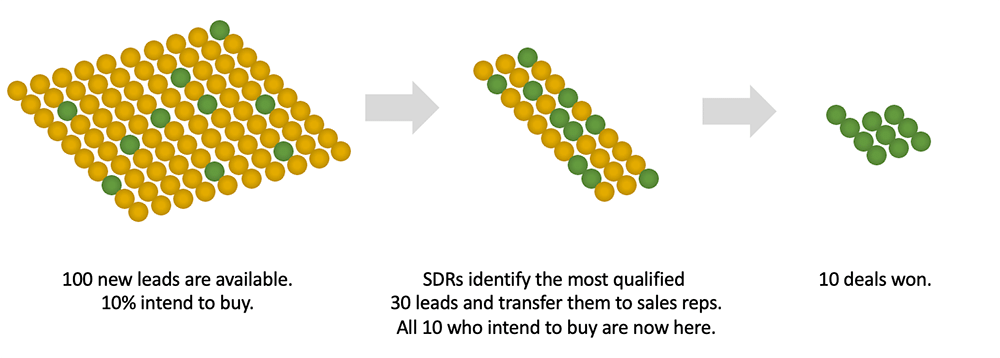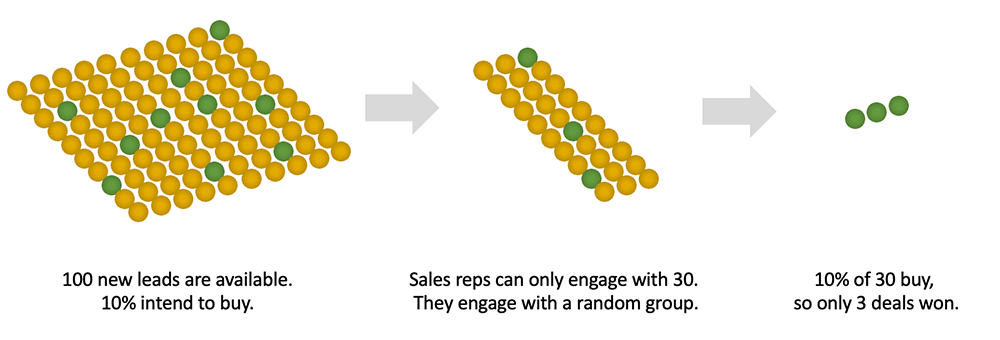Stop Wasting Time with Low-Quality Leads
People walking into a car dealership are not equally valuable customers. Some are serious buyers, some want to see new cars with no intention to buy one anytime soon, and others have unrealistic expectations.
Car salespeople do not have infinite time to spend with everyone who walks into their showroom. They know that they will lose money if they waste time with people just browsing instead of attending to genuine buyers.
To decide who deserves their time, they use simple techniques to quickly rate a potential customer as soon as they come in. How old is this customer? How are they dressed? What kind of car do they have now? Then, they ask a few questions to understand their expectations, backgrounds, and financial means. Within minutes, they decide whether to keep talking or let the customer wander in the showroom by himself.
This is called a lead qualification decision, and it is a vital first step of the sales cycle.
In a growing business, the number of leads is much larger than actual sales opportunities. Lead-to-customer conversion rates in many industries are in the single-digit percentage range. Ratios less than 1% are not uncommon. That means a business may have to engage with dozens, maybe even hundreds of new leads to close just one sale.
At this point, the importance of having a system to identify the leads who are most likely to become customers is evident.
Let’s see this with numbers from a hypothetical example:
Imagine a scenario where you get 100 leads every month, and your lead-to-sale conversion ratio is 10% (i.e., you close one sale for every ten leads you engage with). Let’s assume you need to spend 5 hours on average to visit each potential customer, attend meetings, write proposals and make follow-up calls.
You have about 150 working hours in a month, which allows you to engage with 30 leads a month. If you treat each lead equally and try to sell to all of them, you will have time to talk with only 30 leads and close three sales in a month. You will not have time to engage with the remaining 70 leads.
Now imagine having a separate group of people called Sales Development Representatives (SDR) who quickly screen the available leads and give you a shortlist of 30 leads out of the same 100, 10 of which will be buying. With this knowledge, you can spend the 150 hours you have during that month to talk only with the 30 high-quality leads and still close ten sales.

You can see the impact of qualifying leads before fully engaging with them. Even if your qualification process is not perfect (as in this example where 2/3 of qualified leads still do not buy), you can sell more without hiring additional people.
Qualify Every Lead. No Exceptions.
Many salespeople get excited when someone they don’t know from a large potential buyer calls and requests a quote. They assume this person is qualified and start investing their time. However, weeks pass with no sale.
After countless emails and voice mails, they finally get their contact on the phone who says he forwarded the quote to his manager and the manager has not made a decision yet.
I sent your quote to my manager.
This confirms that the salesperson has been talking to someone who does not have much say in this purchase. At this point, the outcome of the deal does not depend on what the salesperson can do, but whether competitors have managed to reach better contacts and have made a better case.
Properly qualifying leads at the beginning of the sales process can prevent costly mistakes. It can also help identify better leads within the same company if the lead turns out to be unqualified.
A business has limited control over the quality of inbound leads, so the need to qualify them is evident. You do not want to invest your valuable time into anyone who walks into your showroom or fills out a form on your website.
But outbound leads also need to be qualified. You may be the one reaching out to them, but you are doing so without knowing much about them. So you still need to check if you want to work with them.
Never skip the lead qualification step, even if your leads work for the most desirable customers and you specifically targeted and reached out to them first.
How Do You Know If A Lead is Qualified?
A qualified lead must meet specific criteria that indicate a high probability of becoming a customer.
Those criteria vary for every business. Luckily, there are standardized methods you can use to define your criteria (For a discussion of a popular lead qualification method, check out this blog post: Lead Qualification Using The BANT Method).
Lead qualification methods vary on what criteria to use, but in most cases, a short, carefully designed conversation can get you all the answers you need. For example, the BANT method checks the lead has:
- Budget in line with expectations,
- Authority to influence a purchase decision,
- Needs compatible with what the company offers, and
- A Timeframe that makes sense.
A qualified lead must satisfy all of the four requirements.
What you learn during a 5-minute phone call can help you avoid wasting weeks trying to sell to the wrong person.
Ideally, you want to get all the information you need to qualify a lead in just a few minutes. You can do this with a phone call, or in the case of trade shows and other events, with a quick face-to-face chat. In some cases, it may also be possible to collect the information you need to qualify a lead without talking with them at all.
Whose Job Is It?
Many sales managers ask sales representatives to qualify leads and then negotiate deals. But in most cases, having the same person do both is not an optimal strategy.
Lead qualification work involves talking with many people who are not ideal customers. Someone who has to spend a lot of time with dozens of unqualified leads during the day may not switch gears and perform well when talking to actual buyers.
Salespeople are naturally optimistic. They tend to have confidence in their skills to turn things around. But this attitude can lead them to qualifying leads that are not qualified, reducing the overall efficiency of the process.
Having many short conversations with leads and applying objective criteria to disqualify them is difficult for many salespeople who are used to developing deep relationships with customers to maximize sales revenue.
High-performance sales teams have separate Sales Development Representatives (SDRs) specializing in sourcing and qualifying leads.
An SDR’s primary responsibility is to screen new leads, determine if they are qualified, and if there is an opportunity for a sale, connect them with another member of the sales team (typically an Account Executive). Their work with a lead ends with the qualification decision.
Having a CRM that facilitates lead qualification is key to the efficient running of this process and the seamless handover of qualified leads from SDRs to account executives.
Scaling Up
Lead qualification needs to be done on a large scale to yield meaningful results. But before you start to scale things up, spend some time ironing out the kinks. Make sure the qualification calls capture the data you need and the qualified leads convert to paying customers at an acceptable rate.
Keep an eye on your costs. Lead qualification saves valuable time for account executives, but SDRs have their own costs.
Once you are ready to scale, you need to make some decisions.
- Start with estimating the number of new leads you can generate in a given period.
Inbound lead generation requires marketing activities. Outbound lead generation involves internal research teams and external data sources. Both require spending money, so your budget limits the number of leads you can generate in a given period. - Plan for an ongoing process, not a one-time burst.
A common mistake in outbound lead generation is underestimating the available number of targets and thinking a complete list of all possible leads is already available. Companies go out of business; new players come in; people change jobs. You need to keep generating new leads and qualify them constantly. Even the biggest companies do not get to a point where they don’t need to generate more leads. - Consider the lifespan of your newly generated leads.
Leads have a limited lifespan. Waiting six months to call back the leads you generate during a trade show is not optimal. Similarly, the list of purchasing managers you have today may be obsolete in two years. Remember that leads are real people. They move on to other jobs or retire over time. New people take over. You must continue to source new leads and qualify them. - Update your definition of a lead.
Without a constant push to acquire new customers, sales teams can become complacent, settling on a very narrow definition of what a lead should be. “There is a limited number of buyers in this market, and we are already working with most of them” is a common excuse for slow growth. In reality, top growth companies keep redefining their targets and acquiring new customers in new segments. - Consider your business goals and work out your numbers.
If you want to grow sales by 30% within a year, how many new customers do you need? Considering your lead-to-customer conversion rate, how many leads can yield that many customers? Do you have the budget to generate all those leads? How big should your SDR team be to handle this work? Do you have enough account executives to take over qualified leads and close deals?
Remember that this is an iterative process. As your team gains experience and your lead qualification process ramps up, numbers will change, and you will need to make adjustments.
Using TeamGram CRM to Manage Lead Qualification
TeamGram CRM has powerful lead processing capabilities that make it easy to screen and qualify leads.
- Import Leads into TeamGram CRM: If you have a list of leads in an Excel sheet, you can easily import them into TeamGram CRM.
- Scan Business Cards with TeamGram CRM’s Mobile App: TeamGram CRM’s mobile app can read text on a business card using the camera on your mobile device and automatically fill a lead form. Useful to create leads at trade shows and other events.
- Automatically Create A Lead Form and Publish It On Your Website: No need to create leads manually for website form submissions. TeamGram CRM automatically generates a lead every time someone fills out a form.
- Automatically Create Leads From Incoming Emails: Forward incoming email inquiries to a special inbox, and TeamGram CRM will automatically create lead records.
- Star ratings: A quick rating tool allows SDRs to quickly assign a score to indicate the quality of each lead.
- Linkedin, Google and Social Media Searches: See what information is available on various platforms about each lead before calling them.
- Email templates for outgoing messages: Send personalized outreach emails effortlessly.
- Outreach sequences and bulk personalized emails: The ultimate outreach tool. Automatically schedule outreach emails, phone calls and other channels. Send personalized bulk emails with one click. Manage multiple SDRs.
- Conversion to contacts, companies and opportunities: Once you reach a lead and qualify, easily convert it into linked contact, company and opportunity records. For a seamless handover, send the opportunity directly to the sales pipeline of the assigned account executive.
Summary
One of the best things you can do to improve the productivity of your sales team is to implement an effective lead qualification system that helps your account executives focus on the most promising prospects.
Well-defined criteria for qualifying leads are critical to this. To define your criteria, consider utilizing a standardized method like BANT. Then, communicate it to your team.
For maximum efficiency, have a separate team of Sales Development Representatives who will handle lead qualification. Skills and mindset needed for lead sourcing and qualification are different from those required for account management, so having the same person qualify leads and then try to close sales may not be ideal.
Lead qualification becomes useful when you do it on a large scale. It is a numbers game with complex scheduling requirements for thousands of activities. Trying to run things with spreadsheets can quickly lead to chaos. An excellent technical infrastructure like TeamGram CRM will make sure things go smoothly.
Reaching high-quality leads is hard. You will need to try multiple phone calls and emails before you can finally have a conversation with your target. You may need to schedule 10-15 attempts to reach each lead, spread out over many weeks. Check out TeamGram CRM’s lead outreach sequences to manage this operation safely and efficiently.
Some of the TeamGram CRM features mentioned in this article may not be available in all subscriptions. Compare subscription plans, or get in touch with TeamGram to find the best plan for your needs.

